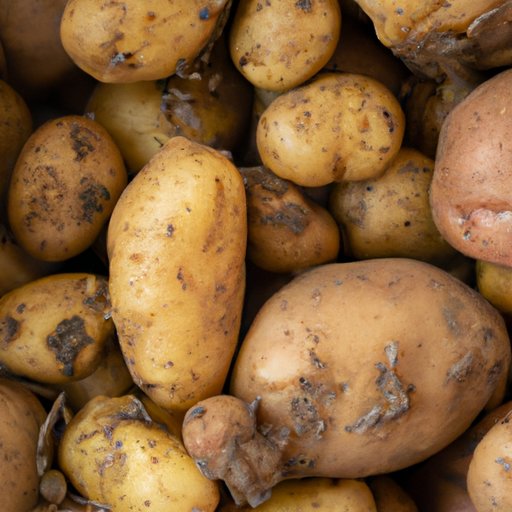
I. Introduction
Potatoes are a staple food in many households, yet there is always a debate about whether or not to eat potatoes that have sprouted and turned soft. It is a common occurrence, especially when potatoes are not stored properly, and many people are unsure whether it is safe to eat them or not. In this article, we will explore the science behind soft and sprouted potatoes, provide practical ways to cook with them, offer tips for storing them properly, and highlight the benefits of consuming potatoes.
II. The Science Behind Soft and Sprouted Potatoes: Should You Toss Them or Use Them Anyway?
Potatoes sprout and become soft due to a natural process that occurs when they are exposed to light and warmth. This process is a sign of growth and can even be promoted by moisture and air. These conditions are perfect for sprouts to emerge from the “eyes” of the potato and create a greenish tint on the skin, indicating higher levels of solanine, a toxic compound in the nightshade family. In general, potatoes that have sprouted and are soft should be avoided or discarded, especially if they have mold or rot on them.
However, while some people prefer to throw out sprouted potatoes, others want to find ways to avoid food waste and utilize them. Research suggests that sprouted potatoes are not at risk for causing harm unless they are very green, soft, wrinkled, or have a bitter taste. Before using them, be sure to cut away any green parts or sunken spots, and discard any that have already begun to spoil.
III. Saving Money and Reducing Waste: Creative Ways to Cook with Soft and Sprouted Potatoes
Salvaging soft and sprouted potatoes is one way to reduce food waste and save money. With a little creativity and preparation, they can be delicious additions to a variety of dishes. For example, roasting them with other vegetables, mashing them for a side dish, or incorporating them into soups and stews can revive them as ingredients with unique flavors.
Here are some tips for cooking with sprouted and soft potatoes:
- Boil sprouted potatoes to soften them, then mash them with butter, salt, and milk for a classic mashed potato side dish.
- Cut off any sprouted areas or soft spots, then cut the potatoes into chunks and roast them in the oven with olive oil, garlic, and herbs.
- Use sprouted potatoes in soups and stews for added texture and flavor.
- Grate sprouted potatoes and cook them in oil until crispy for homemade hash browns.
IV. The Dos and Don’ts of Storing Potatoes: Preventing Sprouts and Spoilage
Preventing sprouts and spoiling starts with storing potatoes properly. The ideal storage conditions for potatoes are in a cool, dark, and dry place, such as a pantry or a cellar. It is important to keep them away from light, moisture, and heat, which can cause them to sprout and decay.
Here are some tips for storing potatoes:
- Store potatoes in a paper or mesh bag to promote air circulation.
- Avoid storing them with onions or other vegetables, as they release gases that can cause the potatoes to spoil faster.
- Do not store them in the refrigerator, as the cold temperatures can cause them to convert starches to sugars, affecting their taste and texture.
- Check them regularly, and remove any that are sprouted or soft to prevent contamination of other potatoes.
V. From Garden to Table: A Beginner’s Guide to Growing Potatoes
Growing potatoes is a fun and rewarding experience that can provide a fresh supply of potatoes to your kitchen. Here are some tips to help you get started:
- Choose seed potatoes that are certified and disease-free.
- Plant them in well-drained soil in a sunny location.
- Water regularly, but do not overwater them, as too much moisture can cause them to rot.
- Hill soil around the plants as they grow, to promote the development of more potatoes.
- Harvest them when the plants begin to die back, and let them dry in the sun for a day or two before storing.
VI. The Health Benefits of Eating Potatoes and How to Make the Most of Them
Potatoes are often misunderstood as an unhealthy and fattening food, but they actually offer many health benefits. They are a good source of carbohydrates, fiber, vitamins (especially vitamin C), and minerals (especially potassium). Eating potatoes in moderation can also help with weight management and blood sugar control, depending on how they are prepared and cooked.
To make the most of their nutritious value, avoid deep-frying or microwaving them in plastic bags, which can create chemical compounds that are harmful to health. Instead, try these cooking methods:
- Bake, roast, or boil them with the skin on to preserve their nutrients and flavor.
- Slice and bake them with olive oil and spices for homemade potato chips.
- Grill, steam, or sauté them as a healthy side dish or salad ingredient.
- Make homemade potato soup or veggie burgers for a nutritious and flavorful meal.
VII. Conclusion
To sum up, eating potatoes that have sprouted and become soft is generally not recommended. However, if you decide to use them, be careful to remove any green parts or spoiled areas and cook them thoroughly. To prevent the risk of sprouting and spoilage, store them in a cool, dark, and dry place, and check them regularly for signs of decay. Growing your own potatoes can also provide an additional source of fresh, nutritious, and tasty produce. By reducing waste and making the most of the food we have, we can contribute to a more sustainable and healthy lifestyle.




